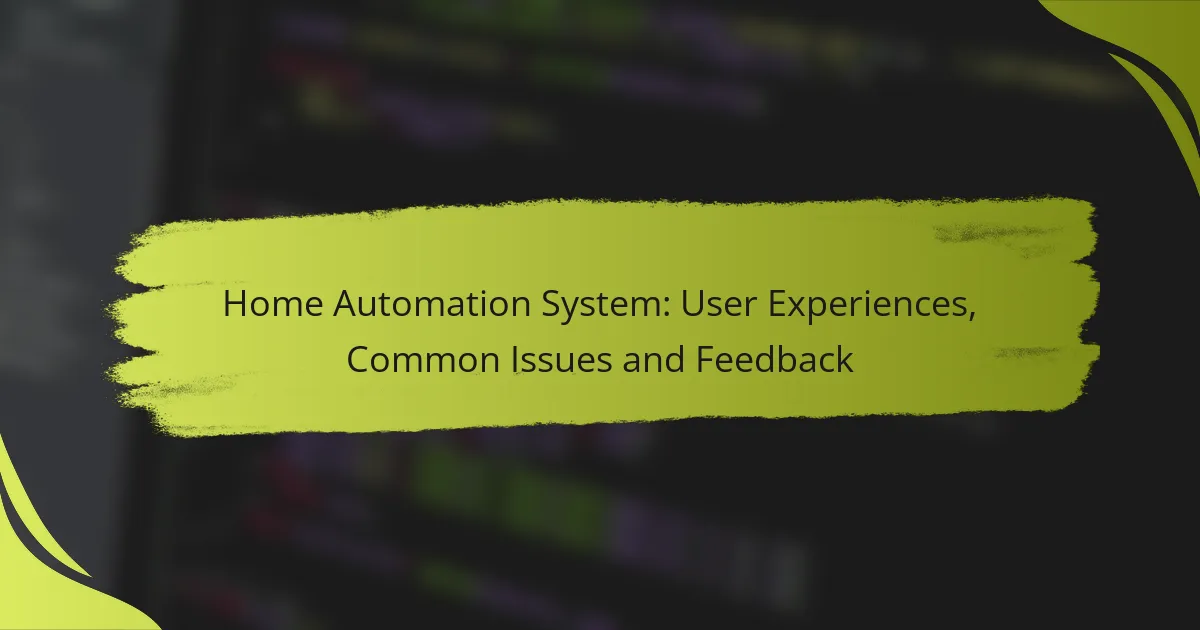Home automation systems have revolutionized modern living by providing enhanced convenience, security, and energy efficiency. Popular options like Google Nest and Amazon Echo allow users to control various devices seamlessly, significantly improving lifestyle and comfort. However, users may encounter common issues that require troubleshooting, such as connectivity problems and device compatibility. Understanding these experiences and challenges can help users maximize the benefits of their home automation systems.
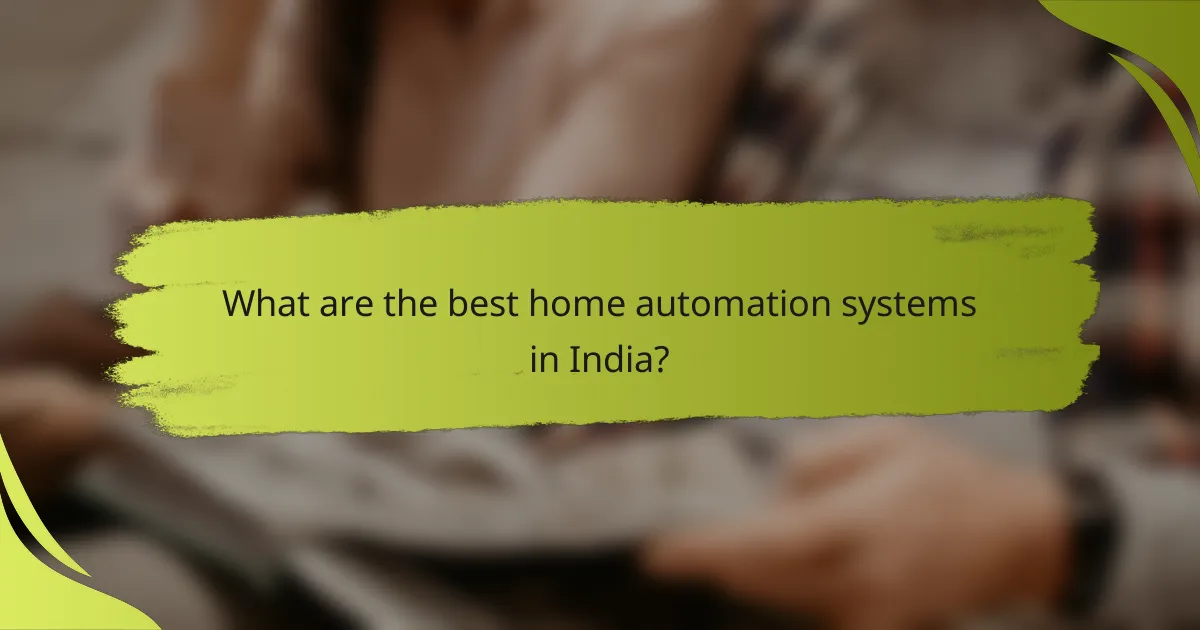
What are the best home automation systems in India?
The best home automation systems in India include Google Nest, Amazon Echo, Philips Hue, Samsung SmartThings, and Wink Hub. These systems offer a range of features that enhance convenience, security, and energy efficiency in homes.
Google Nest
Google Nest is a versatile home automation system that integrates seamlessly with various smart devices. It allows users to control lighting, thermostats, and security cameras through voice commands or the Google Home app.
Key features include smart scheduling, energy usage reports, and compatibility with a wide range of third-party devices. Users appreciate its user-friendly interface and robust voice recognition capabilities.
Amazon Echo
Amazon Echo serves as a central hub for controlling smart home devices using Alexa, Amazon’s voice assistant. It supports a vast ecosystem of compatible devices, making it easy to manage everything from lights to smart locks.
With features like routines and skills, users can customize their home automation experience. The Echo’s ability to integrate with Amazon services adds convenience for shopping and entertainment.
Philips Hue
Philips Hue specializes in smart lighting solutions, allowing users to control their home lighting through an app or voice commands. The system offers a variety of bulbs and fixtures that can change colors and brightness based on user preferences.
Philips Hue is known for its easy installation and compatibility with other smart home systems, making it a popular choice for enhancing ambiance and energy efficiency in homes.
Samsung SmartThings
Samsung SmartThings acts as a comprehensive smart home platform that connects various devices, enabling users to automate tasks and monitor their homes. It supports a wide array of devices, from sensors to cameras.
Users can create custom automations and scenarios, such as turning on lights when someone enters a room. The SmartThings app provides a centralized control interface, making it easy to manage all connected devices.
Wink Hub
Wink Hub is designed to simplify the smart home experience by connecting multiple devices from different manufacturers into one platform. It supports a variety of protocols, including Z-Wave and Zigbee, ensuring compatibility with many smart devices.
Wink’s user-friendly app allows for easy setup and management of devices. However, users should be aware that some features may require a subscription for full functionality.
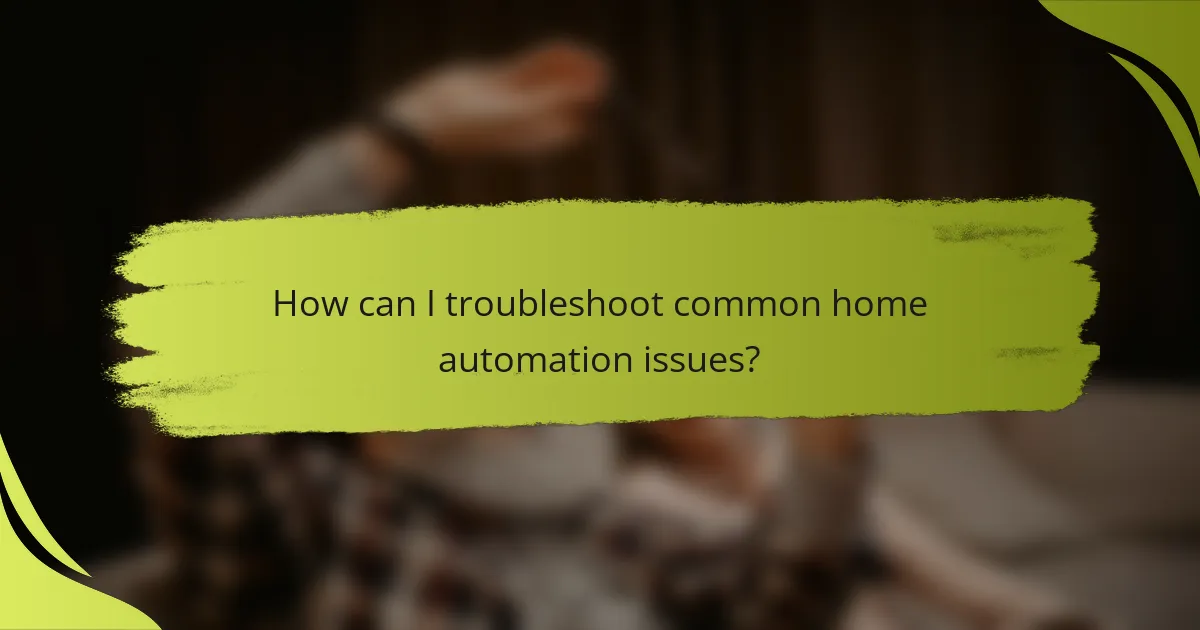
How can I troubleshoot common home automation issues?
Troubleshooting common home automation issues involves identifying specific problems and applying targeted solutions. Start by checking connectivity, device compatibility, power supply, and software updates to resolve most issues effectively.
Connectivity problems
Connectivity issues often arise from weak Wi-Fi signals or interference from other devices. Ensure your home automation hub is within range of your router and consider using Wi-Fi extenders if necessary.
Check for any obstructions, such as walls or large furniture, that may block signals. If devices are still unresponsive, restarting your router and the affected devices can often restore connectivity.
Device compatibility
Not all home automation devices work seamlessly together. Before purchasing new devices, verify their compatibility with your existing system, including protocols like Zigbee or Z-Wave.
Consult manufacturer specifications and user reviews to identify potential compatibility issues. If a device is incompatible, consider using a smart hub that supports multiple protocols to bridge the gap.
Power issues
Power problems can disrupt the functionality of your home automation system. Ensure that all devices are properly plugged in and that batteries are charged or replaced as needed.
For wired devices, check for any blown fuses or tripped circuit breakers. If power fluctuations are frequent, consider using surge protectors to safeguard your devices.
Software updates
Outdated software can lead to performance issues or security vulnerabilities. Regularly check for updates for your home automation system and individual devices, as manufacturers often release patches to improve functionality.
Set devices to update automatically if possible, or establish a routine to check for updates monthly. Be cautious with updates; read release notes to understand changes and ensure compatibility with your existing setup.
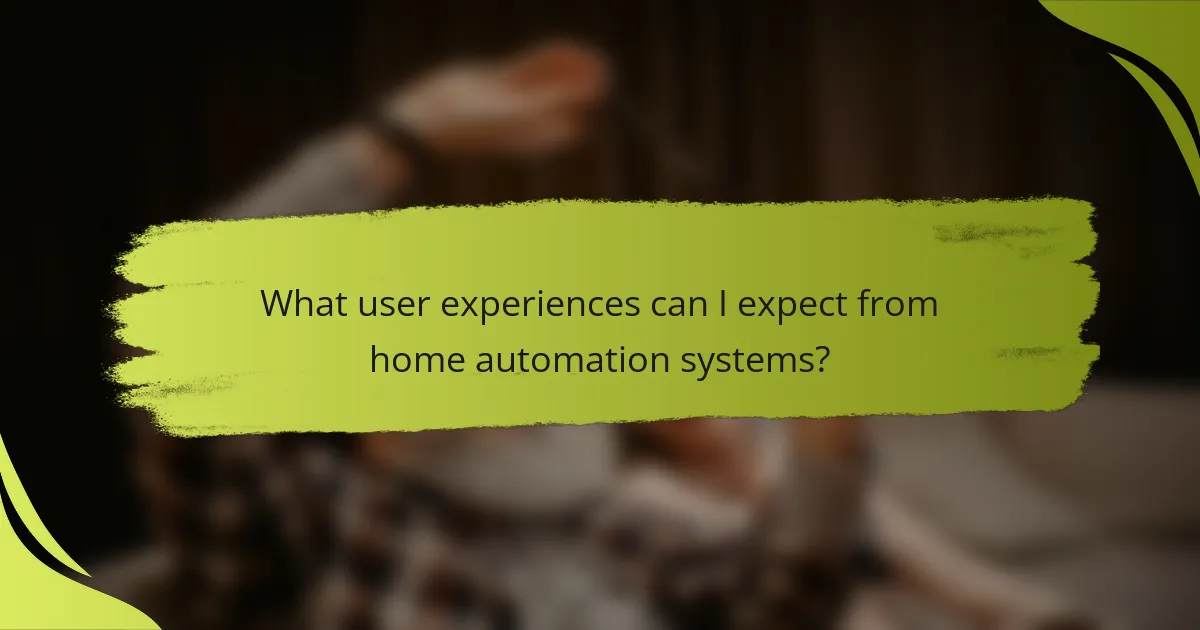
What user experiences can I expect from home automation systems?
Home automation systems offer a range of user experiences, primarily focusing on enhancing convenience, energy efficiency, security, and customization. Users can expect to control various devices seamlessly, leading to improved lifestyle and comfort.
Convenience and control
Home automation systems provide significant convenience by allowing users to control multiple devices from a single interface, often via a smartphone app or voice commands. This centralized control can streamline daily tasks, such as adjusting lighting, temperature, and appliances, making it easier to manage home environments.
For example, users can set schedules for lights to turn on or off automatically, or adjust the thermostat remotely. This not only saves time but also enhances the overall user experience by creating a more responsive living space.
Energy efficiency
One of the key benefits of home automation is improved energy efficiency. Smart devices can monitor usage patterns and adjust settings to minimize energy consumption, leading to potential savings on utility bills. For instance, smart thermostats can learn your schedule and optimize heating and cooling accordingly.
Many systems also provide real-time feedback on energy usage, helping users identify areas where they can reduce waste. Implementing energy-efficient devices can lead to reductions in energy costs by as much as 20-30% over time.
Security enhancements
Home automation systems significantly enhance security through smart locks, cameras, and alarm systems that can be monitored and controlled remotely. Users can receive alerts for unusual activity and access live video feeds from their devices, providing peace of mind whether they are at home or away.
Integrating security features with other smart devices can create automated responses, such as turning on lights when motion is detected or locking doors at a set time. This interconnectedness can deter potential intruders and enhance overall home safety.
Customization options
Home automation systems offer extensive customization options to fit individual user preferences and lifestyles. Users can create personalized settings for different scenarios, such as “movie night” or “away mode,” which adjust multiple devices simultaneously to enhance comfort and convenience.
Moreover, many systems allow for the integration of third-party devices, giving users the flexibility to choose products that best meet their needs. It’s essential to consider compatibility when selecting devices to ensure a cohesive and functional home automation experience.

What are the common feedback points from users in India?
Users in India often highlight installation challenges, customer support issues, and integration difficulties when discussing home automation systems. These feedback points reflect the practical experiences of users navigating the complexities of setting up and maintaining these systems.
Installation challenges
Many users report difficulties during the installation of home automation systems, primarily due to a lack of clear instructions or technical expertise. Common issues include improper wiring, compatibility problems with existing devices, and inadequate tools for setup.
To mitigate these challenges, users should consider hiring professional installers who are familiar with local standards and regulations. Additionally, reviewing online tutorials or community forums can provide valuable insights and troubleshooting tips.
Customer support issues
Customer support for home automation systems in India often receives mixed reviews. Users frequently express frustration over long wait times, unhelpful responses, and limited availability of support channels.
To enhance the support experience, users should document their issues clearly and utilize multiple contact methods, such as phone, email, or chat. Checking for warranty terms and service level agreements can also help set expectations for response times and service quality.
Integration difficulties
Integration of various smart devices can be a significant hurdle for users in India, with many reporting compatibility issues between different brands and technologies. This often leads to a fragmented user experience where devices do not communicate effectively.
To improve integration, users should opt for devices that adhere to common standards like Zigbee or Z-Wave, which are more likely to work seamlessly together. Researching compatibility before purchase and utilizing centralized control apps can also simplify the integration process.
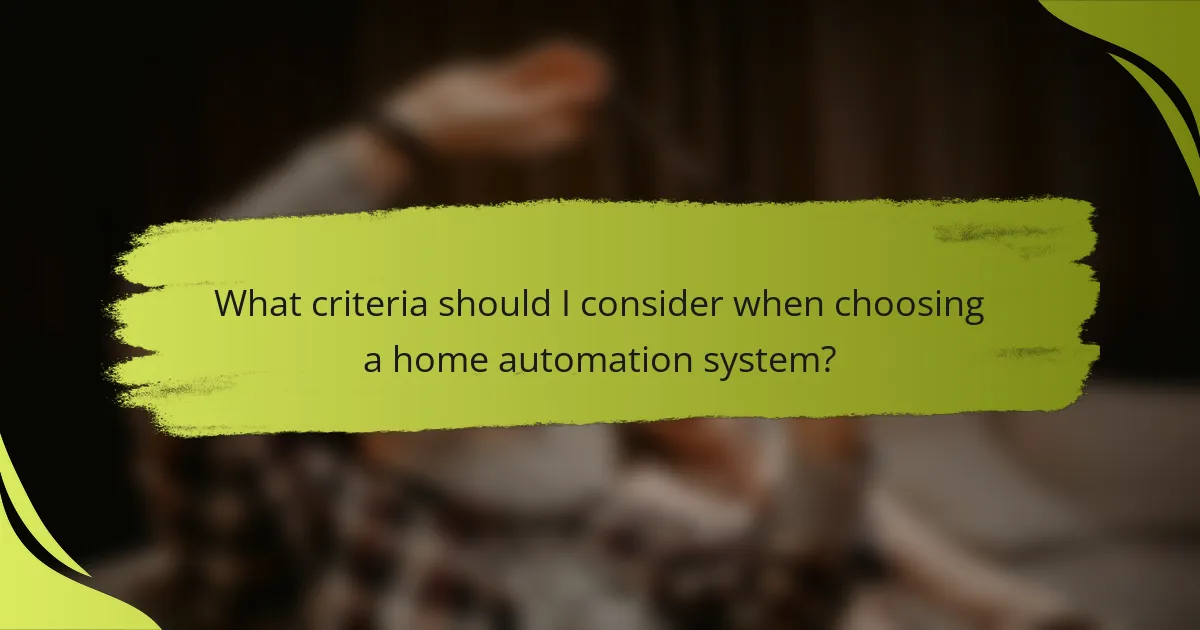
What criteria should I consider when choosing a home automation system?
When selecting a home automation system, consider your budget, desired features, compatibility with existing devices, and ease of use. These factors will significantly impact your overall satisfaction and the system’s effectiveness in enhancing your home environment.
Budget considerations
Your budget is a crucial factor when choosing a home automation system. Systems can range from a few hundred to several thousand dollars, depending on the complexity and features. Determine how much you are willing to invest, keeping in mind potential ongoing costs such as subscriptions or additional devices.
Consider starting with a basic setup that covers essential functions, like smart lighting or security, and expand as your budget allows. This phased approach helps manage costs while still enjoying the benefits of automation.
Feature set
Evaluate the feature set of different home automation systems to ensure they meet your needs. Common features include remote access, voice control, energy monitoring, and integration with smart appliances. Make a list of must-have features versus nice-to-have ones to guide your decision.
Compatibility with existing devices is also vital. Check if the system supports various protocols like Zigbee, Z-Wave, or Wi-Fi to ensure seamless integration with your current gadgets. This can save you from additional expenses and compatibility issues down the line.
